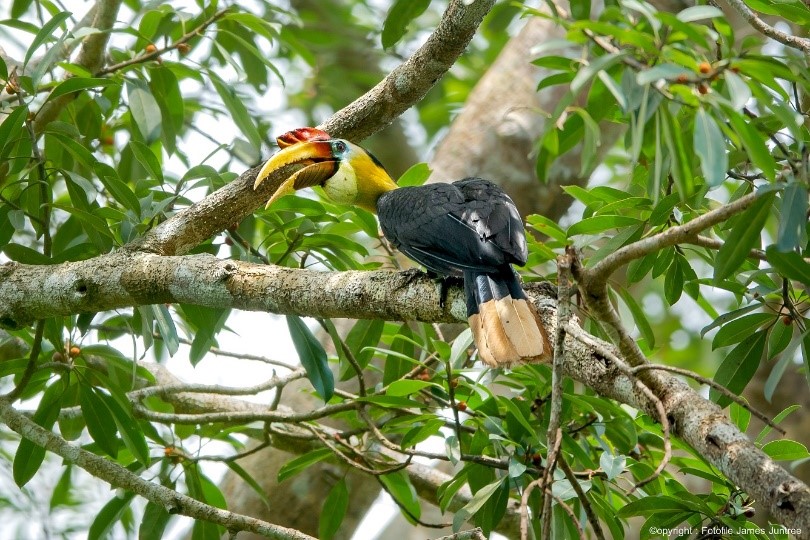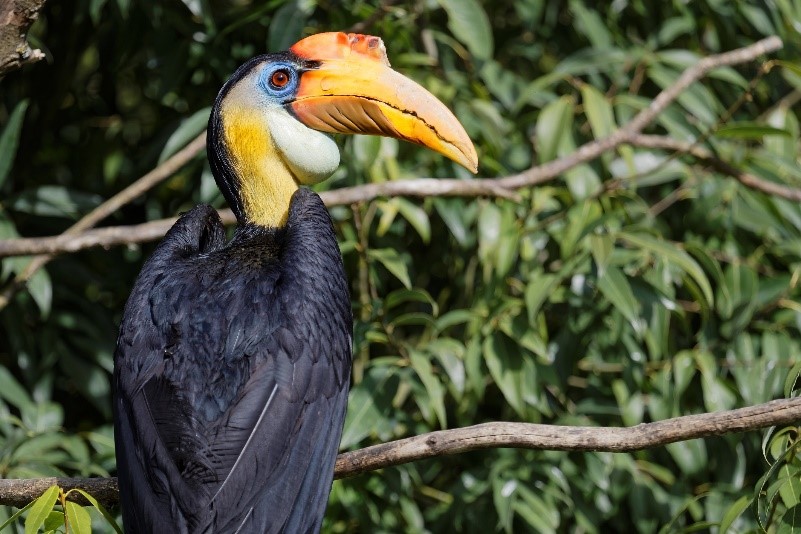September 30, 2024
The wrinkled hornbill, or Sunda wrinkled hornbill (Rhabdotorrhinus corrugatus), is an Endangered bird species that is endemic to Sumatra, Kalimantan and Malay Peninsula, and central to Indigenous culture in Indonesia. While providing a direct link to ancestry, these captivating creatures are also an emblem of conservation efforts in the present.
In this article, we’ll take a closer look at one of Indonesia’s most eye-catching animals, with a few wrinkled hornbill facts that cover behavior, biology, and their importance to forest ecosystems. By focusing on conservation actions currently underway in Restorasi Ekosistem Riau (RER), we’ll also try to assess what the future holds for the remaining hornbills of Indonesia.
Appearance and physical characteristics
What does a hornbill look like? As the name implies, the wrinkled hornbill’s most striking feature is its beak, which features a prominent growth on the upper mandible that is fused to its skull, and is called a casque. A fully grown hornbill measures about 70 cm in length, with mainly black plumage. This monochrome coloration is punctuated by an iridescent ring of blue around the eye, along with golden yellow plumage around the neck and the tips of the tail feathers.

In males, that distinctive casque is accented through a fiery coloration that grades from lemon yellow and amber along the beak, through deep crimson red on the crest. While males have bright yellow feathers on the neck and chest, the female is mostly black, with some blue coloration around the throat. The bill and casque of the female is almost entirely yellow, while the male’s is yellow with a red base and casque.
Diet and feeding behavior
Wrinkled hornbills feed on a wide range of fruits from around their forest home, but will occasionally take small vertebrates (like frogs) and invertebrates (insects). They use their spectacular beak to pluck fruits from branches, manipulating their food with surprising skill and dexterity. Interestingly, wrinkled hornbills never drink – instead, they get all the water they need from the food they eat.
Courtship, nesting, and breeding habits
One of the most fascinating characteristics of hornbill behavior relates to their breeding habits. These birds are monogamous and mate for life. Mated pairs engage in complex courtship displays and build elaborate nests to give their chicks the best possible start in life.
After a female has chosen a suitable nesting site –in the hollow cavity of a tree – the male will ‘brick up’ the entrance using mud and droppings, leaving only a small hole through which he can feed the female (they usually breed during rainy seasons, when there is plenty of moist soil around for building materials). After several months confined to the nest, the female will break free so the chicks can fledge.
This elaborate nesting behavior is very uncommon among birds, and requires equal amounts of devotion, intelligence, and resourcefulness. By securing the nest in this way, the pair protect their brood from predators and the elements. Their solution relies on complete cooperation between male and female.
Ecosystem role and cultural significance
Hornbills are great travelers and have a varied diet. Their tendency to forage over long distances, combined with the diversity of the food they eat, makes them essential seed dispersal specialists in their ecosystem. Fruiting trees are visited by hornbills all over the forest, and the seeds they ingest are then dispersed far and wide in their droppings, helping the jungle stay healthy and biodiverse. In RER, hornbills are just as important to reforestation efforts as the scientists working on the ground below.

Hornbills not only play a vital role in maintaining ecosystem balance; they are also integral to Indigenous culture in Indonesia. For the Dayak tribes of Kalimantan, these birds are a potent symbol of purity, power, and strength. Dayak communities believe hornbills are the messengers of the forest, through which they can communicate directly with their ancestors. Reverence for hornbills is reflected in the dress, dance, and songs of the Dayak tribes, whose belief systems are centered around a divine entity that appears in the form of giant hornbill called ‘Panglima Burung’, or the ‘Bird Commander’.
Conservation status
Are wrinkled hornbill endangered? Unfortunately, despite their importance to nature and culture, many hornbill species are under threat, mostly due to loss of habitat caused by deforestation. The wrinkled hornbill is currently listed as Endangered (EN) by the IUCN Red List of Threatened Species, having been upgraded from Near Threatened (NT) in 2018. This makes conservation efforts essential to ensuring the survival of these incredible birds, which are so important to the ecological balance of their ecosystems – and the spiritual lives of their human neighbors.
RER conservation efforts
The wrinkled hornbill is one of 22 Endangered species documented in the RER area. These animals are endemic to the islands of Kalimantan and Sumatra and Malay Peninsula, where they thrive in lower and middle levels of the forest canopy. To survive and breed successfully, they require undisturbed, primary rainforests, but can also be found in selectively logged areas. This makes RER the ideal setting for their survival, and a testing ground for conservation approaches that can help wild populations to recover elsewhere too.
By studying these animals in their natural habitat, and continuously working to restore the forest around them, RER is committed to providing wrinkled hornbills with everything they need. Just like the other 21 Endangered species that call RER their home, hornbills have found a refuge in Riau where they can not only survive, but thrive; they remain a symbol of color and cultural value, and the captivating natural biodiversity of Indonesia.